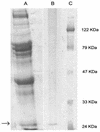Production and characterization of a human recombinant monoclonal Fab fragment specific for influenza A viruses
- PMID: 12853404
- PMCID: PMC164267
- DOI: 10.1128/cdli.10.4.680-685.2003
Production and characterization of a human recombinant monoclonal Fab fragment specific for influenza A viruses
Abstract
A human recombinant monoclonal Fab fragment that specifically recognizes all the influenza A virus strains tested was produced in transformed Escherichia coli using the phage display technique. No strain of influenza B virus reacted with it. It was purified after four cycles of panning and by a single passage through an immunoaffinity column. About 1 mg of pure monoclonal antibody was obtained from 1 liter of culture medium in 3 working days. The Fab fragment reacted with a viral 27-kDa protein, which could reasonably be a matrix protein. Indirect immunofluorescence tests performed on virus-infected MDCK cells showed that this Fab fragment was at least equally efficient as other commercial monoclonal antibody-based systems in detecting influenza A viral infections. The potential advantages of human recombinant Fabs on murine monoclonal antibodies are discussed.
Figures




References
-
- Barbas III, C. F., J. E. Crowe, D. Cabala, T. M. Jones, S. L. Zbedee, B. R. Murphy, R. Chanock, and D. R. Burton. 1992. Human monoclonal Fab fragments derived from a combinatorial library bind to respiratory syncytial virus f glycoprotein and neutralize infectivity. Proc. Natl. Acad. Sci. USA 89:10164-10168. - PMC - PubMed
-
- Bethell, R., and P. Smith. 1998. Recent developments in sialidase inhibitors for the treatment of influenza. Drugs Future 23:1099-1109.
-
- Bucher, D. J., A. Mikhail, S. Popple, P. Graves, G. Meiklojohn, D. S. Hodes, K. Johansson, and P. E. Halonen. 1991. Rapid detection of type A influenza viruses with monoclonal antibodies to the M protein (M1) by enzyme-linked immunosorbent assay and time-resolved fluoroimmunoassay. J. Clin. Microbiol. 29:2484-2488. - PMC - PubMed
-
- Bugli, F., R. Bastidas, D. R. Burton, R. A. Williamson, M. Clementi, and R. Burioni. 2001. Molecular profile of a human monoclonal antibody Fab fragment specific for Epstein-Barr virus gp350/220 antigen. Hum. Immunol. 62:362-367. - PubMed
Publication types
MeSH terms
Substances
LinkOut - more resources
Full Text Sources
Other Literature Sources

